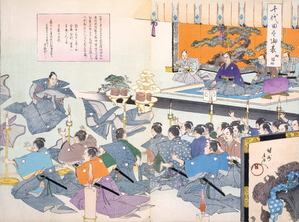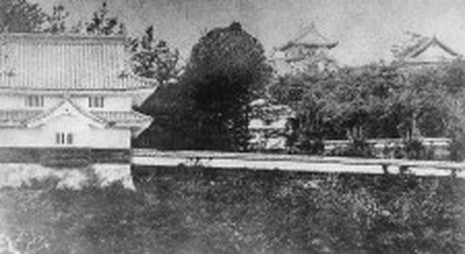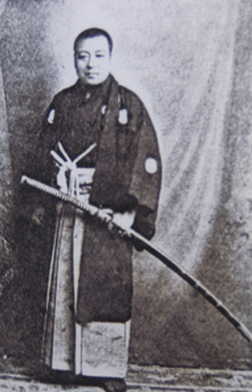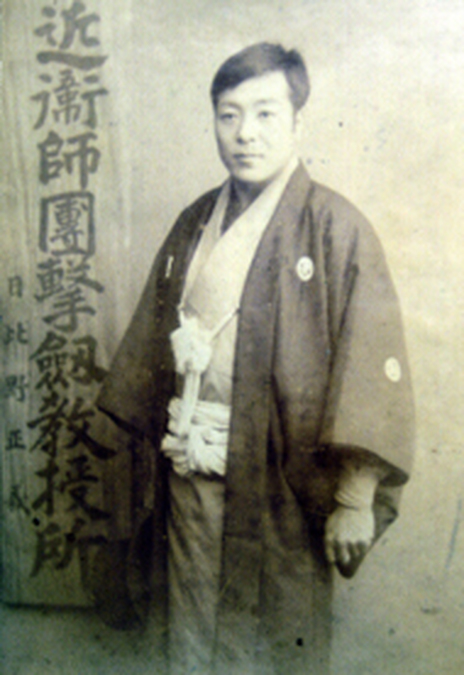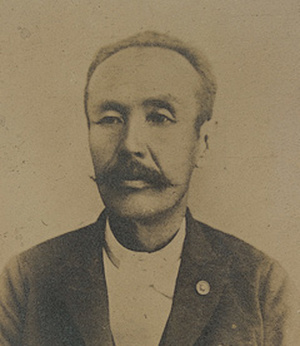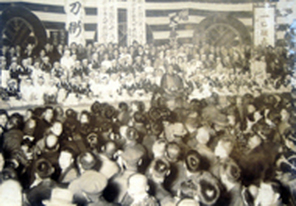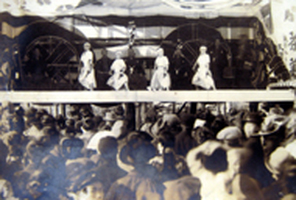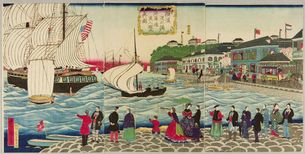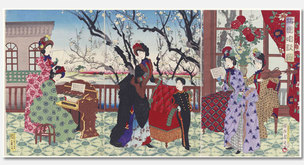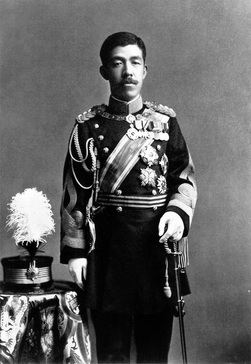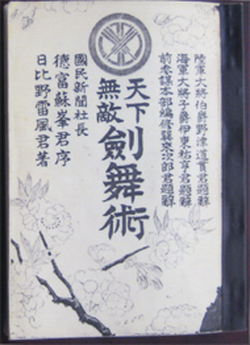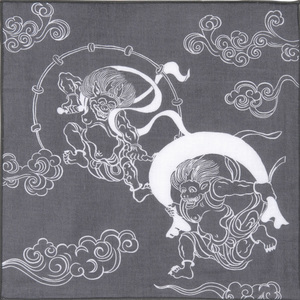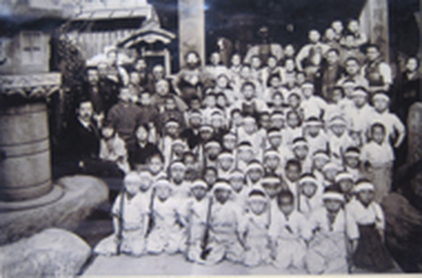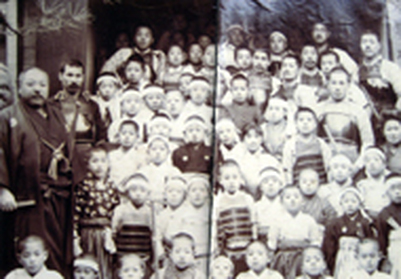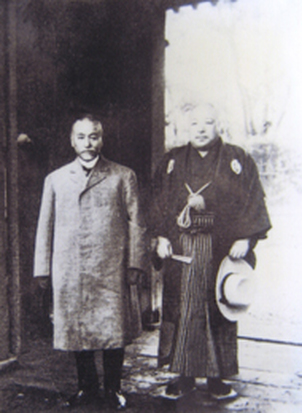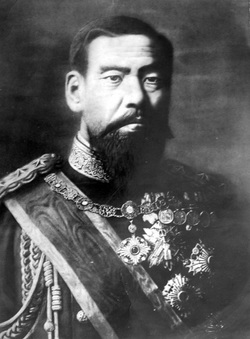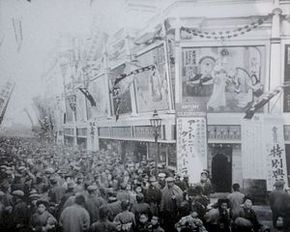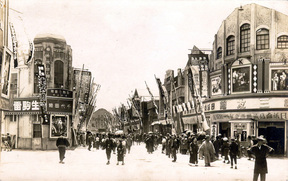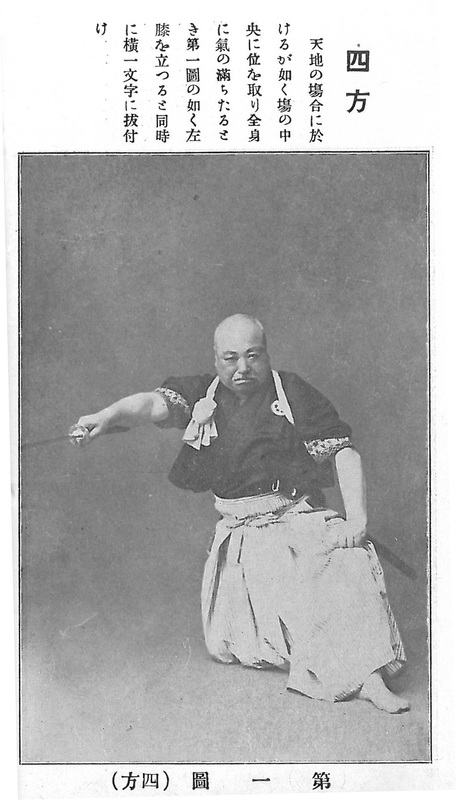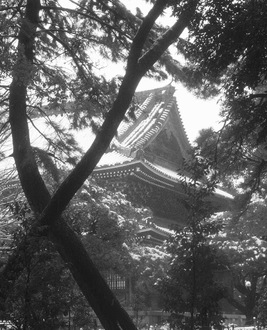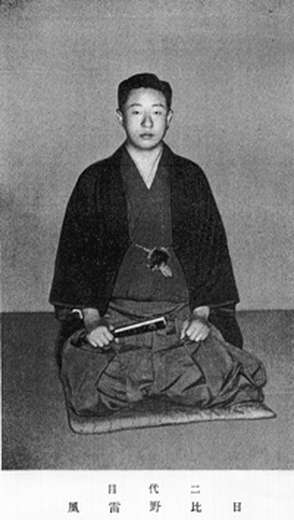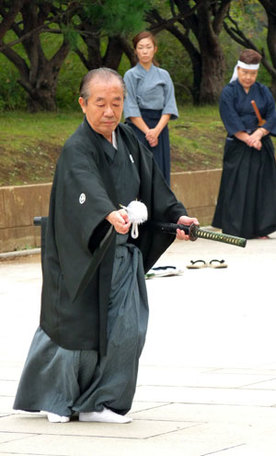History 「由来」
|
INTRODUCTION
When speaking of Seibu Ryu, one cannot avoid speaking about Shinto Ryu. Shinto Ryu embodies a broad collection of Japanese cultural art forms, including sword, traditional dance, music and poetry chanting. Seibu Ryu is the name given to the swordsmanship component of this bigger art, and the term "Seibu" has only recently been used to make this distinction. For this reason, to tell the story of Seibu Ryu we must tell the story of Shinto Ryu. |
|
SHINTO RYU AT A GLANCE
Founded in 1890, Shinto Ryu has an amazingly fascinating story inexorably linked to the rise and fall of the Japanese empire. Born out of the tumultuous Meiji Restoration, it would ultimately boast having more than a dozen dojos and its name would be known across Japan, even by the Emperor. Five books would be written under its name, and it would also be the subject of one of the first films produced in Japan. Then, like the country, it would meet tragedy during WWII, prematurely losing its leader and all traces of his heir. Twenty years later, the heir would finally be found, to be taught about his legacy and the art, and to retake the reigns of leadership. Through his efforts, practitioners around the world have been reunited and the original spirit that founded this great school would be rekindled. While many have contributed to this art, there is none greater than its founder, Hibino "Raifu" Masayoshi. Not only an incredibly talented swordsman, he was also a great thinker brought up in a life of privilege and exposed to some of the greatest minds in Japan. |
|
HIBINO RAIFU - EARLY YEARS
Hibino "Raifu" Masayoshi was born into a samurai family in 1864 at Kagoshima, Kyushu, at Inuyama Castle where his father worked as a swordsmith. Just four years later, with the beginning of the Meiji Restoration and the ultimate fall of the Shogun, the family decided to move to Saitama in the hopes of finding a better life. It was here, at age six, that Hibino would begin learning sword. In 1878, his family arranged an apprenticeship for him with the town's mayor, Negishi Takeka, to learn statesmenship and further his education. Also a sword instructor, Negishi began rigorously training Hibino. However, by the next year, Hibino decided the civil servant's life was not for him and he left for Tokyo to open his own dojo. In the newspaper he advertised, "one match, one penny!" He was only 15 years old. |
|
Within three years, he would be traveling from town to town as part of a 'Kenshibu' troupe, a group of martial artist performers who told age-old stories on stage. Inspired by Noh theater, the stories were told through music, poetry chanting ('Uta'), and two forms of dance: 'Shibu' - a dance that incorporated the warrior's fan; and 'Kenbu' - a dance that incorporated the katana sword. This form was considered not only traditional, but represented the strong 'budo' principles respected by the samurai class. Hibino would become very skilled in this art, particularly his sword dance and poetry chanting.
|
However, it would not be until 1883, when he was 19, when he settled back down and began studying Muto Ryu under Yamaoka Tessyu, a famous samurai renowned for his martial skills, Zen pursuits, and his role in the Meiji Restoration.
|
NEW PURPOSE
The Meiji Period (1868 - 1912) would usher in an age of incredible change that would ultimately shape Hibino's life. This period saw the rise of rapid industrialization, widespread social reform, and the transformation of a feudal society into a world power. The young leaders within the new Meiji government provided a strong vision for a New Japan and the people embraced it full-heartedly. Nationwide, a fervor consumed the people as they refashioned nearly every aspect of their lives. In just a few decades, Japan saw the removal of the samurai class, widespread adoption of Shintoism, and utter support of anything Western; all while the country unified under chants of "Revere the Emperor!" and "Eastern Values!". It was this very zeitgeist that would sweep up Hibino and the martial art world, changing them forever. |
|
Change happened for Hibino in 1888, when he competed in a sword tournament attended by Emperor Taisho (then the crown prince) at what is now the University of Tokyo. Recognized for his skill (and social status) he was invited to the home of the prestigious Shigeno Yasutsugu, a famous historian, where conversation turned towards concern over the health and spirit of the Japanese people. The idea of 'Bunbu Nido' came up, the Zen concept of a warrior who pursues spiritual wisdom, and how such an ideal could lead Japan towards prosperity. This greatly intrigued Hibino. He began contemplating the idea of progress and how it should be measured by more than just material gain. Shintoism promoted reverence for tradition and the pursuit of purity, but what role did the warrior class have in all of this? Inspired, he began contemplating the greater meaning of budo, synthesizing everything he had learned in life.
Just two years later, Hibino introduced Shinto Ryu Kenbujutsu, a school of swordsmanship, tradition, and philosophy. At its core were the martial arts of the traditional samurai, including practical sword training, sparring and components of karate; on top of that, it embraced the traditional arts he learned as a Kenshibu performer, namely the warrior's dance and poetry chanting; and above all, it meshed the ideas of budo, Zen Buddhism and Shintoism, while embracing the strong sense of Japanese identity. Hibino had succeeded in synthesizing the traditional values of the samurai into the new ideas of the modern movement. |
|
ZEN MEETS SHINTOISM
The successful combining of all these ideologies can be no better demonstrated than when Hibino Masayoshi changed his name to Hibino Raifu (in 1896). Inspired by the ancient Shinto gods, Rai-Jin and Fu-Jin, Hibino aspired to embody the values they represented. On one hand, they were both known as fierce guardians, masters of powerful storms who jealously defended Japan and all things sacred. On the other hand, they were credited with removing the mists that had darkened the world, allowing mankind to forever see the heavens. In essence, they exemplified the Zen notion of Bunbu Nido, representing both the warrior's strength and spiritual wisdom. |
|
GREAT POPULARITY
Little is known about how quickly Shinto Ryu became popular at this time. It is known that, after publishing the book "Gekken Education" (撃剣教育論) in 1891, Hibino would offer numerous classes teaching children. By this time, 'budo' principles had become integrated into children's education across the nation and sword work was considered one of the more respected sources for this. |
|
Since his performance for the crown prince, he not only maintained his connections to Japan's elite but developed new relationships, which he used to expand his school. Many of these were top military officials. Most influential was Hibino's friend Admiral Heihachiro Togo who, by 1900, supported him in building thirteen dojos. By this time, there were over 3,000 practitioners.
His popularity would not stop there, though. By 1902, he would have written three more books and, in 1907, he would be invited to perform a private demonstration for Emperor Meiji in the home of the Marquess Matsutaka Masayoshi, who had twice been prime minister. Just a year later, he traveled to Korea to present Shinto Ryu before Sunjong the Emperor of Korea, receiving the book Shisei Kashin as a gift in return. |
|
However, his greatest achievement in popularity would come in 1908 through a little technology called, "film". The testament to how popular Kenbujutsu had become can truly be measured by the number of "firsts" achieved in this endeavor. Produced by Yoshizawa Shoten, the first movie studio in Japan, the film was called “Kenbujutsu Sugekimi Shinto Ryu” (The Dramatic Art of Shinto Ryu Kenbujutsu) and simply featured Hibino Raifu performing his art. It would be one of the first films ever produced in Japan. Premiering on May 1st, 1908, at the Denkikan Theater in Asakusa (the first dedicated movie theater in Japan), it opened with the famous poet, Somei Saburo, narrating.
|
|
LATER YEARS
Shinto Ryu would continue its popularity and recognition. In 1909, Hibino would received a certificate from the Metropolitan Police Force for his major contributions to martial art education. In the years to follow, he would receive other similar certificates from the Gunma, Nagano, Yamanashi, Fukui, Ishikawa and Toyama Prefectures. In 1922, the same year he would write his fifth book, "The Kenbu Road" (剣武の道」発), he would receive one of the most prestigious honors in Zen Buddhism, the title of 'Osho' (monk). He was granted this from the head monk at the Sojiji Temple, one of only two head temples in all of Japan. This honor is granted only to those who have reached a certain level of spiritual enlightenment. |
On June 25th, 1926, at the age of 62, Hibino "Raifu" Masayoshi passed away in Saitama. He was buried at Sojiji temple, where it was said, even in death, he would be able to protect the Zen master there. His tombstone is a 9m tall obelisk with the words, "Invincible Hibino Raifu". And like his namesakes, he would remain as the warrior, forever protecting the Zen masters of the Sojiji Temple, and as the spiritual guide, a paragon of wisdom.
|
FROM SHINTO TO SEIBU
Upon Hibino Raifu's death, there would not be an immediate successor. It would not be until 1936 when his son, Hibino Masaaki, would become old enough to take on the mantle of Soke. Unfortunately, Hibino Masaaki would die prematurely from cancer, in 1948, just three years after the dropping of the atomic bombs in Hiroshima and Nagasaki. His death would leave a vaccuum with no clear heir; his son, Masaharu, was only two years old; his wife disappeared with their son, never to be heard from again. Sadly, Shinto Ryu had lost its bloodline and leader. With no direct heir, the school no longer had a traditional leader; however, it would not be entirely lost. The size of the school allowed for many high ranking students who could preserve the art and faithfully carry on its traditions. Not forgetting that an heir was out there somewhere, they began searching for him. Finally after twenty seven years, in 1972, did they finally find the lost Masaharu, working in Hachioji City Hall. He was 26 years old and had no clue who his father really was or that Shinto Ryu even existed. His father's senior students convinced him to move to Tokyo and claim his birthright. In his own words, "I finally found out who I was. I was the grandson to Raifu." At that time, there were more than 2,000 practitioners in the world, with branches in Brazil, France and Italy. |
|
Seven years before Hibino Masaharu was found, Mochizuki Takeshi had joined the school, already with a 5th dan in Judo under his belt. In 1968 he received his shodan (black belt) and, just five years after Hibino Masaharu returned, he receive the esteemed Renshi Menkyo title which recognized him as a "teacher of teachers". After establishing himself as one of Japan's best cutters, winning the All Japan Iaijutsu Batto tournament in 1981 and the Prime Minister's Cup in 1983, Soke Hibino bestowed Mochizuki sensei with the honorary title of Inka in both Iaijutsu and Battojutsu. The year was 1986. This signified he has completed all training and had achieved a "higher understanding" of the art.
On February 16th, 1990, Mochizuki sensei established Seibujuku for the teaching of Shinto / Seibu Ryu Iai-battojutsu and kama jutsu. He would go on to cultivate the art over then next two decades, imprinting his own understanding to the art. In 2009, the Shinto Seibu Ryu began in Essex, England, under Nick Efreme sensei. In 2010, the Seibu Ryu school started in Seattle, WA USA. |
